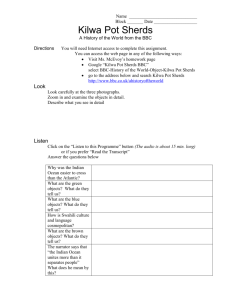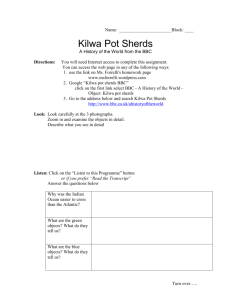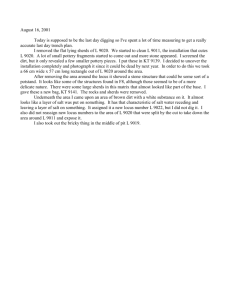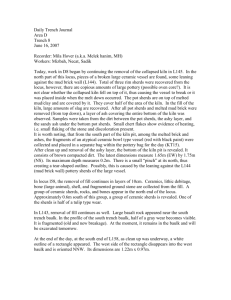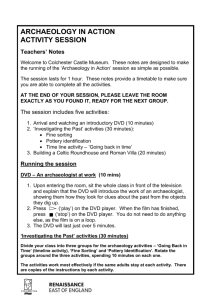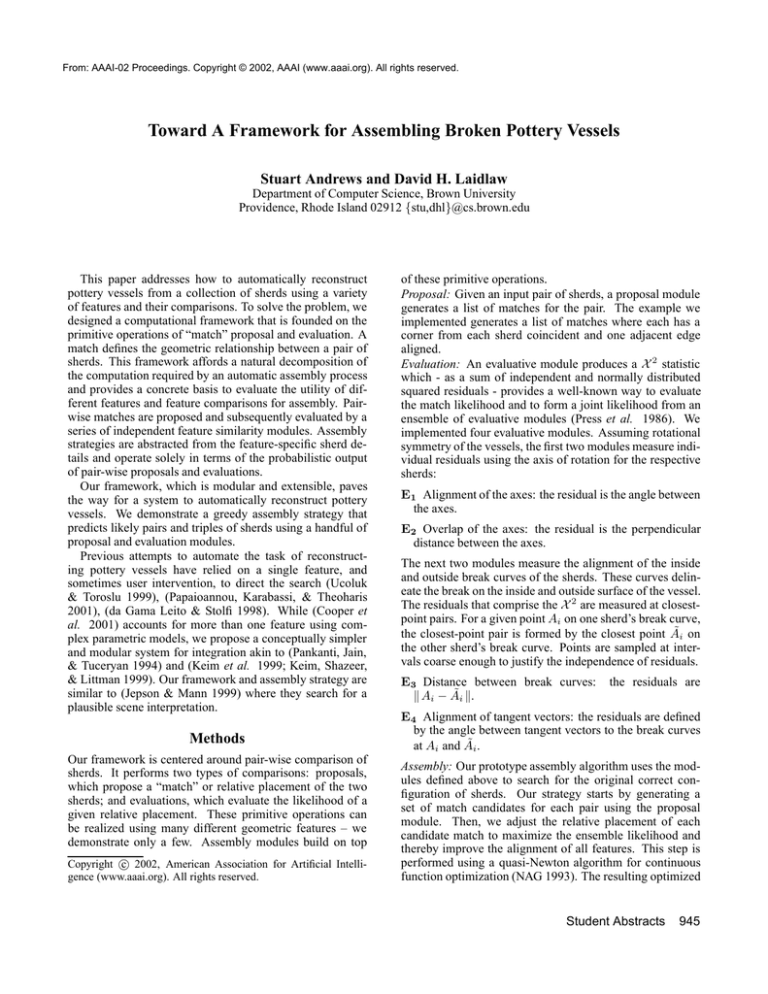
From: AAAI-02 Proceedings. Copyright © 2002, AAAI (www.aaai.org). All rights reserved.
Toward A Framework for Assembling Broken Pottery Vessels
Stuart Andrews and David H. Laidlaw
Department of Computer Science, Brown University
Providence, Rhode Island 02912 {stu,dhl}@cs.brown.edu
This paper addresses how to automatically reconstruct
pottery vessels from a collection of sherds using a variety
of features and their comparisons. To solve the problem, we
designed a computational framework that is founded on the
primitive operations of “match” proposal and evaluation. A
match defines the geometric relationship between a pair of
sherds. This framework affords a natural decomposition of
the computation required by an automatic assembly process
and provides a concrete basis to evaluate the utility of different features and feature comparisons for assembly. Pairwise matches are proposed and subsequently evaluated by a
series of independent feature similarity modules. Assembly
strategies are abstracted from the feature-specific sherd details and operate solely in terms of the probabilistic output
of pair-wise proposals and evaluations.
Our framework, which is modular and extensible, paves
the way for a system to automatically reconstruct pottery
vessels. We demonstrate a greedy assembly strategy that
predicts likely pairs and triples of sherds using a handful of
proposal and evaluation modules.
Previous attempts to automate the task of reconstructing pottery vessels have relied on a single feature, and
sometimes user intervention, to direct the search (Ucoluk
& Toroslu 1999), (Papaioannou, Karabassi, & Theoharis
2001), (da Gama Leito & Stolfi 1998). While (Cooper et
al. 2001) accounts for more than one feature using complex parametric models, we propose a conceptually simpler
and modular system for integration akin to (Pankanti, Jain,
& Tuceryan 1994) and (Keim et al. 1999; Keim, Shazeer,
& Littman 1999). Our framework and assembly strategy are
similar to (Jepson & Mann 1999) where they search for a
plausible scene interpretation.
Methods
Our framework is centered around pair-wise comparison of
sherds. It performs two types of comparisons: proposals,
which propose a “match” or relative placement of the two
sherds; and evaluations, which evaluate the likelihood of a
given relative placement. These primitive operations can
be realized using many different geometric features – we
demonstrate only a few. Assembly modules build on top
c 2002, American Association for Artificial IntelliCopyright gence (www.aaai.org). All rights reserved.
of these primitive operations.
Proposal: Given an input pair of sherds, a proposal module
generates a list of matches for the pair. The example we
implemented generates a list of matches where each has a
corner from each sherd coincident and one adjacent edge
aligned.
Evaluation: An evaluative module produces a X 2 statistic
which - as a sum of independent and normally distributed
squared residuals - provides a well-known way to evaluate
the match likelihood and to form a joint likelihood from an
ensemble of evaluative modules (Press et al. 1986). We
implemented four evaluative modules. Assuming rotational
symmetry of the vessels, the first two modules measure individual residuals using the axis of rotation for the respective
sherds:
E1 Alignment of the axes: the residual is the angle between
the axes.
E2 Overlap of the axes: the residual is the perpendicular
distance between the axes.
The next two modules measure the alignment of the inside
and outside break curves of the sherds. These curves delineate the break on the inside and outside surface of the vessel.
The residuals that comprise the X 2 are measured at closestpoint pairs. For a given point Ai on one sherd’s break curve,
the closest-point pair is formed by the closest point Ãi on
the other sherd’s break curve. Points are sampled at intervals coarse enough to justify the independence of residuals.
E3 Distance between break curves:
k Ai − Ãi k.
the residuals are
E4 Alignment of tangent vectors: the residuals are defined
by the angle between tangent vectors to the break curves
at Ai and Ãi .
Assembly: Our prototype assembly algorithm uses the modules defined above to search for the original correct configuration of sherds. Our strategy starts by generating a
set of match candidates for each pair using the proposal
module. Then, we adjust the relative placement of each
candidate match to maximize the ensemble likelihood and
thereby improve the alignment of all features. This step is
performed using a quasi-Newton algorithm for continuous
function optimization (NAG 1993). The resulting optimized
Student Abstracts
945
sherds. Our strategy utilizes a multi-feature match likelihood computed by independent evaluation modules and
demonstrates how one can extend pair-wise match likelihoods to handle triples and larger configurations of sherds.
References
Figure 1: (by row) match proposals, ranked matches and
best triples.
matches are then ranked according to their maximized ensemble likelihood values. Finally, we use a greedy strategy
to select pair-wise matches to form triples. These are optimized in a similar fashion as the pairs by defining a threeway match likelihood as the sum of the three measurable
pair-wise match likelihoods.
Results
The following section documents the results of our assembly
algorithm when applied to a subset of 8 neighboring sherds
from a 16 sherd test vessel. Of the 28 possible pairs, there
are only 13 valid pair-wise matches in the correct reconstruction. The first row of the Figure depicts the geometry of two
corner alignments and two examples of proposed matches.
Next, we show the top four optimized matches for one pair
of sherds from the vessel rim ranked by decreasing ensemble likelihood [0.999, 0.863, 0.574, 0.548]. For this pair,
the ensemble likelihood identifies the correct match. In the
same way, this procedure correctly identifies 6 out of the 13
valid matches. Nine correct matches are ranked among the
top three matches per pair. In the last row, we show the most
likely triples found by merging pairs and evaluating according to the 3-way likelihood described above; only the last
one is incorrect.
Discussion and Conclusions
Our framework paves the way for a completely automated
reconstruction system. There still remains several unresolved issues such as how to automate feature segmentation and how to deal with missing or faulty data. While
our framework provides a foundation for the development
and testing of reconstruction algorithms, an efficient working system has yet to be developed.
The main contribution of this work is the design of a modular and extensible framework for vessel assembly. We validate this framework by demonstrating a prototype reconstruction algorithm that identifies likely pairs and triples of
946
Student Abstracts
Cooper, D.; Willis, A.; Cao, Y.; Han, D.; Leymarie, F.;
Orriols, X.; Mumford, D.; et al. 2001. Assembling virtual
pots from 3D measurements of their fragments. In VAST
International Symposium on Virtual Reality Archaeology
and Cultural Heritage.
da Gama Leito, H. C., and Stolfi, J. 1998. Automatic reassembly of irregular fragments. In Universidade Fedral
Fluminense (Estadual de Campinas), Technical Report IC98-06.
Jepson, A., and Mann, R. 1999. Qualitative probabilities
for image interpretation. In ICCV (2), 1123–1130.
Keim, G.; Shazeer, N.; Littman, M.; Agarwal, S.; Cheves,
C.; Fitzgerald, J.; Grosland, J.; Jiang, F.; Pollard, S.; and
Weinmeister, K. 1999. PROVERB: The probabilistic cruciverbalist. In AAAI / IAAI, 710–717.
Keim, G.; Shazeer, N.; and Littman, M. 1999. Solving
crossword puzzles as probabilistic constraint satisfaction.
In AAAI / IAAI, 156–162.
NAG. 1993. NAG Fortran Library. 1400 Opus Place,
Suite 200, Downers Grove, Illinois 60515: Numerical Algorithms Group.
Pankanti, S.; Jain, A. K.; and Tuceryan, M. 1994. On
integration of vision modules. In CVPR, 316–322.
Papaioannou, G.; Karabassi, E. A.; and Theoharis, T. 2001.
Virtual archaeologist: Assembling the past. In IEEE Computer Graphics and Applications, volume 21, 53–59.
Press, W. H.; Flannery, B. P.; Teukolsky, S. A.; and Vetterling, W. T. 1986. Numerical Recipes: The Art of Scientific
Computing. Cambridge, UK: Cambridge University Press.
Ucoluk, G., and Toroslu, I. H. 1999. Automatic reconstruction of broken 3-d surface objects. Computers & Graphics
23(4):573–582.

